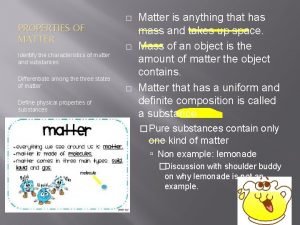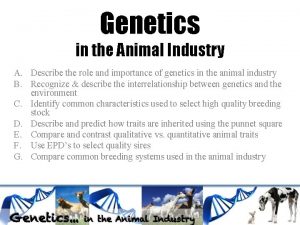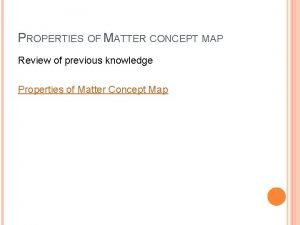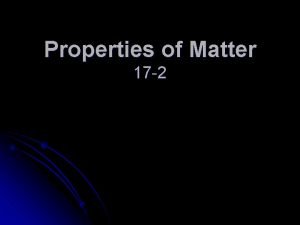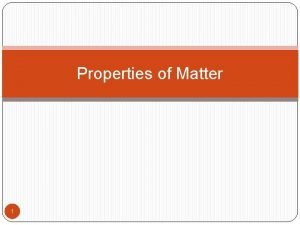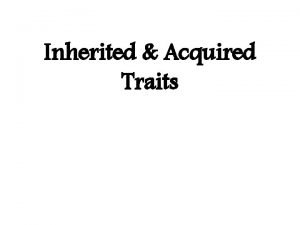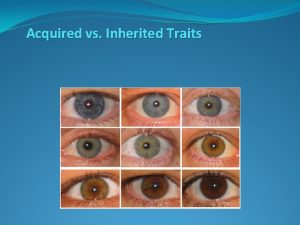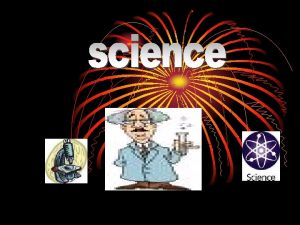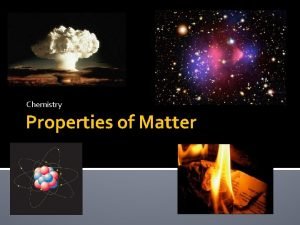Properties of Matter Properties are the characteristics traits


















- Slides: 18

Properties of Matter § Properties are the characteristics, traits, or behaviors that we can use to identify samples of matter and distinguish them from one another. § Water, for example, has different properties than aluminum.

Two TYPES of Properties § Physical properties can be changed without changing the composition of the material itself. § Chemical properties, if changed, would result in the formation of a new substance.

Physical Properties § Physical properties are any characteristics that could change without forming a new substance. § Size, shape, color, taste, odor, magnetism, and temperature all physical properties.

Chemical Properties § Chemical properties are characteristics that can be observed when a material changes into a new substance. § Chemical changes are often accompanied by the release or absorption of energy in the form of heat, light, or sound.

Physical or Chemical Change? § A physical change DOES NOT form a new substance. § A chemical change DOES form at least one new substance.

Videos Physical & Chemical Change Song Physical Changes Song PROPERTIES SONG

Physical Properties § Mass is the amount of matter that makes up an object. § Volume is the amount of space an object takes up § Weight is the force of gravity on an object. § MASS v. WEIGHT video clip 1 , 2, 3

Physical Properties § Density is the amount of matter packed into a given volume § Melting point is the temperature at which a substance changes from solid to liquid. § Boiling point is the temperature at which a substance changes from liquid to gas. § Density Clip 1 , 3 § Distillation Videos 1 , 2 , 3

Physical Properties § State (or phase) of matter describes whether a substance is a solid, liquid, gas, or plasma. § Luster is how well a substance reflects light. § Texture is how rough or smooth a substance is.

Physical Properties § Electrical conductivity is how easily a substance allows electricity to flow through it. § Thermal conductivity is how easily a substance allows heat to flow through it.

Physical Properties § Malleability is the ability of a substance to be hammered without shattering § Ductility is the ability of a substance to be stretched into a wire. § Malleability & Ductility video clip 1

Physical Properties § Hardness is a measure of a substance’s resistance to scratching § Tenacity is a substance’s strength against being pulled apart. § Elasticity is the ability of a substance to return to its original shape after being stretched. Tensile strength (tenacity) test video clip 1 , 2 , 3 Elasticity video clip 1 , 2

Physical Properties § Porosity is the ability of a solid to allow fluids to pass through it. § Solubility is the ability of a substance to dissolve in another substance. § Viscosity is the tendency of a liquid to resist flowing. § Porosity video clip 1 , 2 , 3 § Solubility video clip 1 , 2 § Viscosity video clip 1 , 2 , 3, 4

List of Some Physical Properties § Size, shape, color, taste, odor, magnetism, temperature, mass, volume, weight, density, melting point, boiling point, state or phase, luster, texture, electrical conductivity, thermal conductivity, malleability, ductility, hardness, tenacity, elasticity, porosity, solubility, viscosity

Chemical Properties § Reactivity is how well a substance combines chemically with other substances. VIDEO 1 , 2 , 3 , 4 § Acidic substances behave like acids. VIDEO 1 , 2 , 3 § Basic substances behave like bases. VIDEO 1 , 2 , 3

Chemical Properties Flammability is a material’s ability to burn when exposed to oxygen. VIDEO 1 Combustible materials tend to burn more rapidly in the presence of oxygen. VIDEO 1 , 2

Chemical Properties § Corrosive substances “eat away” other substances VIDEO 1 § Tarnishable substances may have their luster reduced by chemical reactions. VIDEO 1

Chemical Properties § Explosive substances react violently when in contact with other substances. VIDEO 1 § Photosynthetic substances are able to undergo photosynthesis. § VIDEO 1, 2
 Insidan region jh
Insidan region jh Properties and characteristics of matter
Properties and characteristics of matter Qualitative traits vs quantitative traits
Qualitative traits vs quantitative traits Qualitative traits vs quantitative traits
Qualitative traits vs quantitative traits Qualitative traits vs quantitative traits
Qualitative traits vs quantitative traits Section 1 composition of matter
Section 1 composition of matter Grey matter
Grey matter Classification of matter section 1 composition of matter
Classification of matter section 1 composition of matter Chapter 2 matter section 1 classifying matter answer key
Chapter 2 matter section 1 classifying matter answer key Optic tract
Optic tract Classification of matter section 1 composition of matter
Classification of matter section 1 composition of matter Gray matter and white matter
Gray matter and white matter Grey matter and white matter in brain
Grey matter and white matter in brain Ecological succession
Ecological succession State the properties of liquid state
State the properties of liquid state Properties of matter vocabulary
Properties of matter vocabulary Concept map about matter
Concept map about matter Objectives of properties of matter
Objectives of properties of matter Common properties of matter
Common properties of matter

